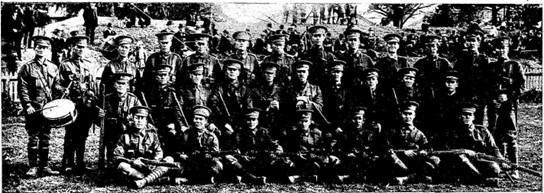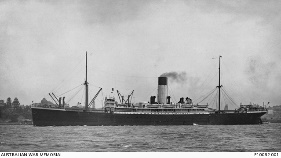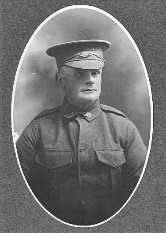
Herbert John WESTMORELAND
Eyes blue, Hair light brown, Complexion fresh
Looking for Herb, one of those buried in the sap
Can you help?
Private Herbert John Westmoreland is one of nine men buried by his comrades in their own sap (a short covered trench or tunnel that has been dug towards an enemy position to provide cover). However, several of the nine were recorded by the Germans and are now identified and resting in the new Pheasant Wood Military Cemetery at Fromelles. Was the original burial site reopened by a German shell?
If we are to identify Herb Westmoreland, it is important to find relatives who share Herb’s DNA, from both sides of the family.
Herb and his immediate family came from Adelaide.
Earlier generations came from Great Grimsby, Lincolnshire (his father’s family base) and, on his mother’s side, from Yorkshire. We are searching for relatives who would share his DNA (see panel at end of story).
Fromelles Association would be very grateful to hear from any family connections.
Herbert John Westmoreland was born at home - Vernon St, Norwood, Adelaide, South Australia - on 24 August 1885 to John and Harriet (nee Pearson). He was the only son of their six children. He had a twin sister, Charlotte Elizabeth (Lizzie) and four other sisters – Mary (died young), Catherine, Nellie and Harriet (jnr). His twin sister Lizzie died in 1911.
Herb’s English-born father, John, was a bootmaker and in 1900, the family moved to Broken Hill. Harriet, born in South Australia, died in New South Wales in 1905, aged 57; she is buried in Broken Hill. The family moved to Melbourne where John established the Westmoreland Boot Lace Co, which still existed in 1951. Herbert, as the only son, worked at the factory.
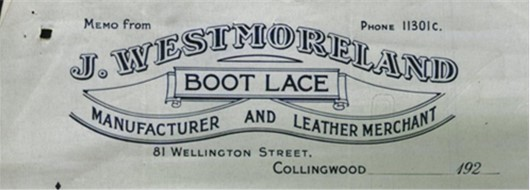
Of Herbert’s five sisters, the eldest, Mary 1870-75, died young and the youngest, Harriet 1888-1923, did not marry. The three middle sisters married and raised families:
- Catherine 1874-1959, married George Lee (1901) and then Donald Castles (1914)
- Nellie 1878-1957, married Thomas Woollacott (1908)
- Lizzie 1885-1911, married Spencer Rayner (1907).
John Westmoreland married twice more after the death of his wife, Harriet, but he had no further children.
Herbert off to War
Herb, aged 29, enlisted on 10 July 1915 in Melbourne and was assigned to the third platoon in A Company in the newly formed 29th Battalion. Having enlisted as part of the recruitment drive that followed the landing at Gallipoli, and having seen the casualty lists, these were men who had offered themselves in full knowledge of their potential fate.
After a short period of training in Victoria, the 29th left Australia on 10 November 1915 on the HMAT A11 Ascanius .
They arrived in Suez, Egypt, disembarking on 7 December. Training and defence of the Suez Canal continued until mid-June with postings at Ismailia, Tel el Kebir, Ferry Post and Moascar. While in Tel el Kebir in March 1916, the troops were reviewed by the Prince of Wales.
The Western Front
The call to the Western front came in mid-June 1916. On the 16th they boarded the troop ship Tunisian in Alexandria, heading to Marseilles, arriving there on the 23rd. Their arrival was well received with French citizens lining the streets to welcome the troops.
The Battalion took the train to Hazebrouck and on to Steenbecque and by the 26th were encamped in Morbeque, about 30 kilometres from Fleurbaix.
On 1 July they moved back to Hazebrouck where training included the use of gas masks for the possible use of “lachrymatory shells” – tear gas. Training was tough. One day included a march of sixteen miles carrying 75 pounds of kit, which only the youngest and fittest could complete - although Private James Lang (858) of Glengarry Victoria described it somewhat light-heartedly in his letter home:
“We are all well loaded with gear-each of us has a gas helmet, steel shrapnel helmet and goggles, and a fellow looks like a blessed Xmas tree.”
On July 9th they moved to Erquingham, just outside of Fleurbaix and on the 10th they got their first experience in the frontline trenches but returned to Fleurbaix on 14 July. Preparations for an attack continued and on 19 July, Herbert was in the trenches with his A company, ready for battle. The 8th Brigade’s position was on the left side of the 5th Division, in the Cellar Farm area (see map below).
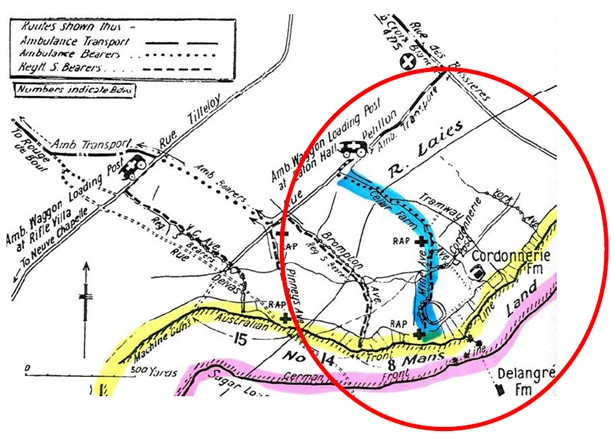
By 8pm, the soldiers were ready, with A and D Companies in the front trenches. Many of the men broke through the forward lines of German trenches looking for what they had been told was a second line. Instead, all they found were a series of shallow drainage ditches.
At 2am the German counterattack began, but as noted in the War Diaries, “After a struggle, Germans content to stop at their own trench.”
At 3:45am on 20 July, with machine guns firing at them, some 150 men from the 29th who were being held in reserve joined in the attack. The attack on their right was altered and they became exposed in a salient jutting into the German lines and were quickly enfiladed by German machine guns. In the end, they basically had to fight their way back to their own lines, 'run for it', or be killed, wounded, or captured.
As noted on the Australian War Memorial website, the nature of this battle was summed up by one soldier from the 29th: "the novelty of being a soldier wore off in about five seconds, it was like a bloody butcher's shop”.
What happened to Herbert?
Herb was killed in the battle and his body has not been identified. His death was not confirmed until the Court of Enquiry was finalised on 20 July 1917, exactly one year after he was killed in action.
In the Red Cross Missing and Wounded witness statements, mostly taken a year after the battle, there are conflicting reports from his friends about his death. This is not surprising given the chaos in the trenches during the battle and in the immediate aftermath, and it is no wonder records of deaths and burials are often non-existent or contradictory.
On September 5th, 1992, Lambis Englezos spoke with Bill Boyce, 58th Battalion and survivor of the Battle of Fromelles, who said:
“Well my job was to help dig a communication trench across from our own lines to theirs and as such you just didn’t have bayonets…. And the instructions were that when a man in front of you fell who was badly wounded or dead, you just rolled him to one side to the side that most of the fire appeared to be coming from – of course this was in the dark, and we didn’t have very much idea – and put a good heaping of earth over him…”
Reports of Herb’s death were unfortunately all secondhand rather than eyewitness reports. The first Red Cross statement from fellow members of the 29th Battalion was as early December 1916 and the latest in October 1917:
- 6 December 1916 - Corporal 413 William Braden stated that Private 376 Edward Waters had reported Herb killed in action. The corporal had no further details and there is no statement from Pte Waters on file. Waters, also a member of A company, survived the Battle of Fromelles but was killed in action in March 1917.
- 12 July 1917 - Pte 2038 John Grieve stated that in November 1916 Pte Allan Camm (sic) had told him that Herbert had been “killed as he went over the parapet on the 19th July at Fleurbaix”. Grieve reported that Camm had said that he (Camm) had actually seen Herbert drop. Red Cross investigations eventually identified the soldier as Pte 1988 Allan Bernard Cann and sought his firsthand account.
- 29 October 1917 - Pte 1988 Allan B. Cann’s reply contradicted Waters’ evidence stating that Cann was with Herb “until we reached the German Front line Trench.” He went on to state that he had then lost sight of Herb when their section became disorganised. Immediately after the battle, Cann made enquiries as to Herb’s welfare but had no news of him. He offered to continue to make enquiries.
A further statement (undated) was made to the Red Cross that Pte H. J. Westmoreland was one of nine soldiers killed on the evening of 19-20 July 1916 and buried on 22 July as part of a larger group of twenty or thirty in a grave in a sap (a short trench to provide cover) near Water Farm, Pozieres. This reference to Pozieres was a common mistake of the times relating to French placenames. The sap where the grave was described is probably on the Mine Ave end of the trench (marked in blue in the map above) near where the water hole is marked.
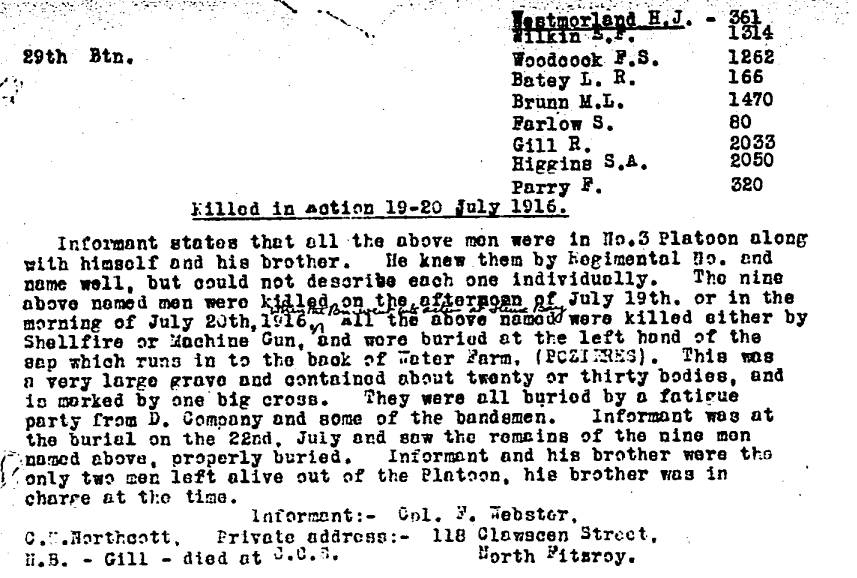
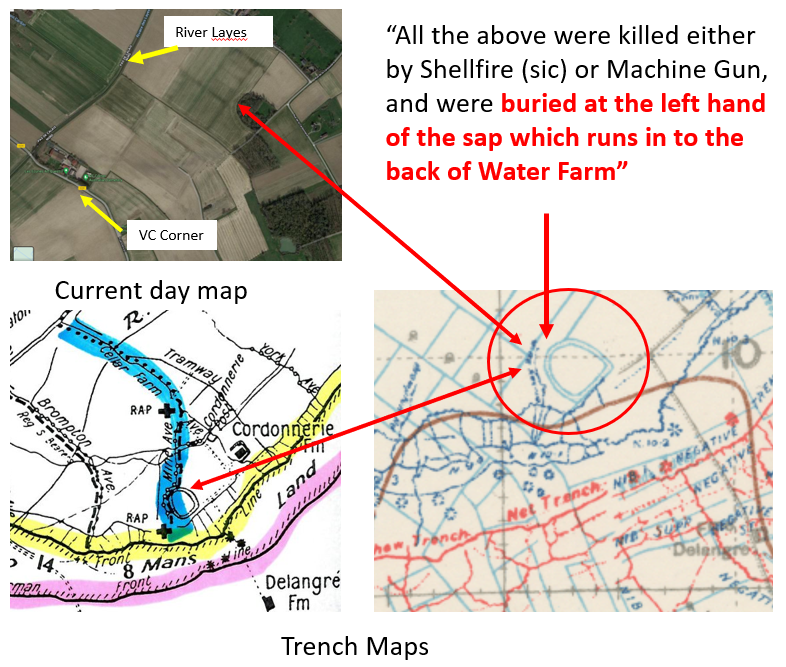
Individual soldiers mentioned in the list of nine were recovered by the German Army, buried in the mass graves and, post-2009, identified by DNA and re-interred at the Pheasant Wood cemetery at Fromelles. There are also similar notes in these soldiers’ AIF files that they are buried at Fleurbaix, and a general map reference, sheet 36, with the exception being Private Robert Gill who died at the casualty clearing station and is buried at the Bailleul Communal Cemetery Extension.
It would have been chaos in the trenches during the battle and in the immediate aftermath, and it is no wonder records of deaths and burials are often non-existent or contradictory. There are no records of these soldiers being found in this vicinity. However, in 2008 a burial ground was located at Pheasant Wood behind the old German front line at Fromelles that contained the bodies of 250 British and Australian soldiers.
Many of their identities, including Fred, were confirmed through a combination of anthropological, archaeological, historical and DNA techniques.
To date (2023), DNA testing has been able to identify 177 of these 250 soldiers.
Despite being identified as being buried in the sap, four of these nine men - Ernest Wilkin, Frederick Parry, Samuel Farlow and Norman Brumm – were identified in 2010 as being buried in the Pheasant Wood Cemetery! Was the original grave disturbed by shelling or otherwise re-opened necessitating re-burial by the Germans?
With four already identified, are the remaining four (Herbert Westmoreland, Francis Woodcock, Lemuel Batey and James Higgins) still amongst those soldiers now buried at the Pheasant Wood cemetery but unidentified?
We are still seeking donors for DNA matching to identify the remaining four and, for Herbert Westmoreland, we are particularly seeking mt DNA on his mother’s Pearson line. If you have information – on either the Westmoreland or Pearson lines – we would love to hear from you.
Herbert Westmoreland has no known grave but he is still remembered. His name appears on panel 1 of the VC Corner memorial at Fromelles and on the Australian War Memorial (panel 116) in Canberra. His family have not forgotten.

Can you help?
We understand that UWCA hold 1 Family Reference Sample (FRS) of mt DNA and 1 of Y DNA. Second mt DNA and Y DNA FRS samples are still needed for family connections to:
| Soldier | Herbert John WESTMORELAND, 1885-1916, Adelaide, South Australia |
| Parents | John WESTMORELAND, b. 1851 Great Grimsby UK d. 1937 Mordialloc, Victoria and Harriet PEARSON b. 1848 Mt Barker SA d. 1905 Broken Hill, NSW |
| Grandparents | |||
| Paternal | John WESTMORELAND and Mary MARSHALL, Great Grimsby. UK | ||
| Maternal | John PEARSON (b. Norway) and Catherine HILLAM of Yorkshire, both died South Australia. |
Note - Earliest known Ancestors: Nancy HODGSON and John HILLAM of Hahndorf SA.
Seeking DNA Donors

Contacts
(Contact: carla@fromelles.info or geoffrey@fromelles.info).
(Contact: army.uwc@defence.gov.au or phone 1800 019 090).
Donations
If you are able, please contribute to the upkeep of this resource.
(Contact: bill@fromelles.info ).
